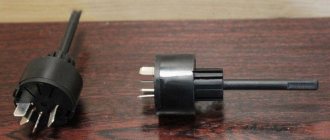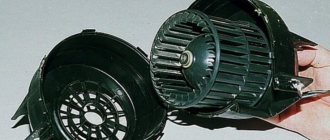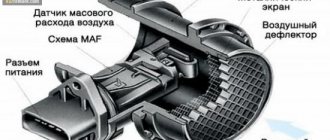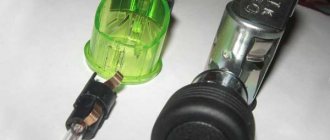This post is not without humor))
Even before buying a car, I heard about problems with electrical systems in Samara. So I had to face this myself.
Since I’m not much of an electrician or mechanic, I still started digging for information on the Internet. At the beginning of winter, as always happens, the heater fan and the rear window heating stopped working when the ignition was on (everything worked when the ignition was off). In winter, it’s simply not possible to drive without a heater, or you can, but like in a tank, with a scraper in your hand. I started digging for information on this part. I didn’t find anything intelligible, but even then I began to blame the contact group of the ignition switch or something connected with it, since the F7 20 A fuse was in order, the mounting block also became in order after removing it, cleaning and drying it in the fall (gifts from The previous owner removed the fire pit by covering it with half a 5 liter plastic bottle) and visually did not find any jambs in the wiring.
I removed and connected the black box, again not without swearing. Well, why couldn’t AvtoVAZ engineers make the wiring with chips 5 cm longer? Did you spare the wires or what?
I had no experience in replacing or reassembling the lock, it was winter, so in short I didn’t go there. I drove in the winter, you won’t believe it!)) On the handbrake. Since the alarm is on autostart, the handbrake is not tightened, and the car does not stall when the ignition is off, but the heater was working)))
I could have driven like this for another month until it warmed up, but then this heater shut down completely (if it weren’t okay, as my great-grandmother said), even with the handbrake, taking with it the windshield washers, the rear wiper, and the rear heating. glass, and lighting for the junk drawer, in short, it looks like everything that hung on the F7. The wipers continued to work. I looked at fuse F7, which is intact. I started digging for information again.
Most of the advice focused on the ignition switch unloading relay at best and on the wiring, mounting block and short circuit at worst. I decided to start with the easiest one. It turned out that the ignition switch had nothing to do with it at all. Some electricians advised, like buy a new one and don’t worry about rebuilding the old one. Moreover, it would still have to be removed in order to buy a similar one from the 10... But I show promise as an inquisitive car owner and decided not to spend money on it until I find out everything and look at the condition of its contact group.
Anyway, I bought a relay, it costs 38 rubles. He crawled under the steering wheel with a flashlight in his teeth, legs up. Again, not without swearing and strong language. Some advice was to move it first, wake up the relay without replacing it after identification, throw it off - put on the chip and tighten the nut on the stud. (well, it’s very uncomfortable there because). The one with it also has the rear fog light relay attached. Tightened it, moved it, everything worked. And you no longer need to drive with a handbrake. No replacement needed!
Actually, why did I write all this down? In principle, there is information on the Internet and on the website, but in some places there are no photos, or it is not clear where the relay is, in others there are no symptoms of the disease. I decided to have everything in one place.
I would be glad and grateful if someone read to the end and this material will be useful to someone.
Many motorists have encountered the fact that the heater fan on a VAZ-2114 stopped working. There are many reasons for this effect, and they can occur at any time. So, in this article, we will look at the reasons why the heater fan may not work, as well as methods of elimination.
Description of fuses and relays on the ECU
Fuse order from top to bottom
- Fuse for fuel pump (15A).
- Fuse for the radiator electric fan relay, canister purge valve, DS, DC, mass air flow sensor (7.5A).
- Fuse for the electronic control unit, ignition module (7.5A).
It is worth noting that on the first models all fuses near the ECU were rated at 15A.
Relay order from top to bottom
- Fuel pump switch relay.
- Relay for turning on the electric radiator fan.
- Main relay.
Cleaning and flushing the radiator of the VAZ 2114/15 stove
You can increase the efficiency of the stove by cleaning and flushing the radiator. The procedure can be performed without dismantling the radiator or with dismantling it. In the first case, you will need to remove the outlet and inlet pipes from the heater and pour a cleaning solution into it. Citric acid, plumbing cleaners (for example, “Mole”), etc. are used as such a solution. Then the radiator is washed with running water and coolant is added. You can clean the radiator better by removing it from the car. This will allow you to wash it not only from the inside, but also from the outside, removing dirt between the honeycombs. Washing is usually carried out with running water.
If after performing these procedures the stove does not work better, the radiator must be replaced.
Video: flushing the stove radiator
Thus, diagnosing a malfunction and determining the cause of poor heating of the VAZ 2114/15 interior with your own hands is quite simple. Self-repair and replacement of individual elements of the heating system are also not very difficult. It is enough just to strictly follow the recommendations of specialists.
(6 votes, average: 4.5 out of 5)
How to check the fuse?
Next you need to find the faulty one. There are two ways (depending on the type of fuse).
We either simply take it out and see if the middle part is intact (in the photo - burnt out on the left, serviceable on the right).
The second method is more accurate. The fact is that the human eye may not notice a burnt jumper.
We do the following: Turn on the non-working circuit (for example, dimensions), without removing the fuse, look at the voltage at one end of the fuse, then at the other. If there is voltage at one end, but not at the other end, then the fuse has blown.
Problems with the cooling system
When the heater on a VAZ-2114 does not work, reasons other than electrical may lie in the coolant circulation system:
- Airlock. As the coolant cools, air accumulates in the upper part of the radiator. Subsequently, air enters the thermostat and a large circle of coolant movement is blocked. The heater core remains cold. There are many ways to fix the problem. But the easiest thing is to squeeze out excess air from the system. To do this, unscrew the cap from the tank. With the engine running, the cold hose is intensely compressed, causing air to escape into the reservoir. If this method does not work, you will have to disconnect the hose to remove the air lock.
- Radiator. Few people devote time to maintaining their car, and especially the heating system. The internal space becomes clogged with dirt, which impedes the flow of coolant. The outer multi-cellular surface becomes clogged with dust and foreign objects, which interferes with heat transfer. In this case, only cleaning the radiator and replacing the cabin filter will help.
- Water pump. Wear of intake blades leads to a decrease in productivity and, consequently, a drop in pressure. Reduced idle pressure is unable to supply heated coolant to the radiator. Only high engine speeds allow you to create the necessary pressure.
- Low coolant level. An antifreeze level below the minimum provokes airing of pipelines. You just need to add antifreeze to the maximum level.
- Cylinder head gasket. A gradual decrease in coolant level, intense white smoke from the exhaust system and the smell of gasoline (oil) in the tank indicate a burnt-out gasket. Through the gap that appears, antifreeze enters the cylinders and into the crankcase with oil. Replacing the gasket requires removing a large number of parts.
- Thermostat. The operating principle of the thermostat is based on the property of a certain metal to change its original shape when the temperature rises. If the element fails, the coolant moves in a small circle without entering the heater radiator. In this case, only replacing the thermostat will help.
- Faucet. It regulates the flow of coolant, that is, the temperature inside the car. If it breaks, the fluid flow stops. Although it is held on by two screws, it is installed in a hard-to-reach place, under the dashboard, which is associated with certain difficulties.
- Hoses. Connecting rubber hoses become unusable after prolonged use. They crack and break. Through the formed cracks, the system depressurizes, and consequently, antifreeze leaks, air gets inside, etc.
The fuse blows
If fuses are blowing frequently, then you have a wiring problem that needs to be fixed. In this case, it is better to entrust the electrical check to a specialist.
The Lada 2115 was first released in 1997 and finished production in 2012. Over such a long period of time, the electronic components of the car have changed significantly. It is not surprising that modifications of the mounting blocks have changed more than once, and with them the fuses of the VAZ 2115.
An old-style car with a carburetor required one installer in the engine compartment. With the advent of a new 8-valve injector, a second unit was needed, installed in the cabin under the dashboard. Some of the new relays were placed under the steering wheel during the 2007 and 2008 upgrades.
The design of the mounting block box has become more modern over time. To make life easier for drivers, a diagram was placed on the lid and tweezers were attached for replacing elements.
Why the VAZ 2114 stove does not work and how to fix it: all the reasons
What a pleasure it is when you dive into your Ladushka from the cold, turn on the stove, and within five minutes you feel that you are starting to thaw and warm up. The air in the cabin gradually warms up, and you can take off your warm, thick jacket or coat that restricts movement.
The stove may not work for many reasons
But it may happen that you turn the knob on the panel, but the desired heat is not there. The heater has stopped working, it blows cold air into the cabin, or it doesn’t blow anything. Is it possible to solve this problem on my own? Can. But first you need to understand why the stove on the VAZ 2114 does not work, and why it refuses to heat you. There may be several such reasons.
Relay under the hood
The main one is the fuse box near the engine. The vast majority of fusible protective elements and almost all relays are located here. During the existence of the model, its modifications changed several times. The most common modern block was presented in 2008. In this release, the arrangement of individual elements has changed slightly and new ones have been added.
You can find the block in the engine compartment above all the devices in the engine compartment. It is protected by a cover that can be easily opened by pressing two latches.
Diagnosis of stove malfunctions
The design of the stove is quite simple. It would seem that there is nothing to break here. The heater cannot break down completely, since its design consists of components independent from each other. However, some elements can fail quite often. These include:
- radiator;
- tap;
- pipes;
- resistor;
- mode switch.
Heater radiator malfunctions
The main reasons for the failure of the stove radiator:
- clogging;
- the appearance of a leak (depressurization).
In the first case, deposits accumulate on the inner walls of the radiator tubes. They can form as a result of:
- long-term operation of the radiator;
- use of low-quality coolant;
- getting dirt, friction products, water, etc. into the cooling system.
As a result, the circulation of antifreeze in the heater radiator is disrupted or completely stopped, and the air entering the cabin does not have time to heat up normally. In winter, it will be cold inside the car, and defrosting the windshield will become a real problem.
A leak in the radiator can appear as a result of corrosion and drying out. Coolant leaking from the heater usually forms a puddle on the floor under the panel on the passenger side. In addition, a characteristic odor will appear in the cabin, and an oily coating will form on the windshield due to evaporation of the coolant, reducing the driver’s visibility. The latter is especially true when driving against the sun or at night, when oncoming traffic is moving with its headlights on.
Stove tap leaking
The stove valve may fail for two reasons:
- souring of the locking mechanism;
- drying out of the device casing.
If the stove has not been used for a long time, the tap may become sour. In this case, when trying to open the tap, you should not use much force, as you can damage the tap itself or break the control cable.
When the housing dries out, the leak may not be immediately noticeable. But after some time, signs similar to those of a radiator leak will appear (a puddle of coolant on the floor, a pungent odor in the cabin, an oily coating on the windshield).
If the heater valve is faulty, coolant begins to leak into the cabin.
Wear of pipes
Antifreeze from the heater radiator may begin to leak through the inlet and outlet pipes as a result of their wear under the influence of chemically active substances included in the coolant and high temperature. In addition, the pipes can be damaged if the clamps that ensure the tightness of the connections are over-tightened.
There are a total of four pipes in the heating system of the VAZ 2113–15 - two in the engine compartment, connecting the engine to the tap, and two in the cabin, going from the tap to the heater radiator. Coolant leakage can occur in different ways. In one case, the antifreeze will flow onto the engine protection and onto the street, in the other - into the car interior. In any case, it will appear as:
- drop in coolant level in the expansion tank;
- puddles forming under the car or in the cabin;
- the appearance of an unpleasant odor in the cabin.
If the heater pipes are damaged, coolant may begin to leak into the passenger compartment.
Resistor failure
The stove resistor consists of two windings and serves to change the resistance of the electric current supplied to the fan. The fan motor can operate in three modes, which can be changed using a switch.
In the third mode, the fan is supplied with a voltage equal to the voltage of the on-board network, and it operates at full power. When the second mode is turned on, the voltage decreases due to one of the windings, the resistance of which increases to approximately 0.2 Ohms. The fan begins to rotate noticeably slower. And finally, in the first mode, the resistance of the windings increases to 0.8 Ohms, and the power of the electric motor is reduced to a minimum.
The main sign of resistor failure is the fan operating only in the third mode. The reason for this is the burnout of one or both windings.
If the resistor fails, the stove operates in only one mode
Switch failure
The cause of a non-working interior heater can only be determined after checking each of its elements. Sometimes the stove mode switch itself may fail. This occurs quite rarely as a result of oxidation or destruction of its contacts.
Use the switch to change the fan speed
VAZ 2115 fuse diagram
The most common models are 3722010 (since 2004) and 21150 3722 010 10. The set of protective elements of electrical equipment in them is not very different from each other, but there are differences, and they are reflected in the decoding of the diagrams below.
The main mounting block under the hood of the car.
The asterisk indicates older configurations. Relay
| K1 | Headlight cleaners |
| K2 | Turn signal and hazard warning switch |
| K3 | Wiper |
| K4 | Lamp integrity |
| K5 | Window lifters |
| K6 | Sound signals |
| K7 | Heated rear window |
| K8 | High beam |
| K9 | Near |
Additional unit in the cabin
| Circuit breakers | Power, A | What is he responsible for? |
| 1 | 15 | Main relay |
| 2 | 15 | Constant power supply to the controller |
| 3 | 15 | Fuel pump |
| K4 | Fuel pump |
| K5 | Cooling fan |
| K6 | Main relay |
Starter fuse and relay
The VAZ 2115 retractor should be looked for on the device itself. To check it without removing the device, lift the hood cover and place it between the fan radiator and the engine. On diagrams it is often referred to as a blocking switch. The contact protection relay is called additional. The photo shows what it looks like.
Cigarette lighter fuse
It is numbered F4 with a rating of 20 Amps. The new ones are marked as F7 with a power of 30 A. The element often does not work due to short circuits.
Fuel pump fuse and relay
Placed in an additional interior mounting block under the glove compartment. The first is marked as F3 and its power is 15 A, and the number of the second is K4.
Where is the relay and ignition fuse located?
It is located in the cabin, under the instrument panel on the driver's side.
VAZ 2115 heater fuse: where is it located?
F7 and rated at 30 Amps is placed in the cabin.
Fan
Generator
A three-level voltage regulator relay was placed on the installation. It can be seen right next to the wires coming from the latter.
Turn signal relay
Lada 2115 has been marked K2 since 2006. Located in the engine compartment mounting block.
Heated rear window
The answer is F4, with a power of 20 A.
Windscreen wipers
Fuse element number F7.
Stop signals
F3 rated 7.5 Amps.
Radio tape recorder
Reverse fuse
Idle relay
Located on the throttle assembly.
Wipers
This is #3. The main signs of its malfunction are a sudden stop of the windshield wipers and their intermittent operation.
Lamp health monitoring relay
No. 4 in the main block.
Where is the fog light relay located?
Located on the fender near the battery. Or trace its position through the wires from the fogs themselves.
Which fuse is responsible for the power windows on the VAZ 2115
Primary installer element F6, rated 30 A.
Low and high beam
Interior lighting
No. 3 at 7.5 A is responsible for it.
Charger
The battery fuse is installed on the battery.
central locking
You need to determine the location of the wiring harness going to the installer, where the insert is located.
Emergency crew
Dimensions
The protection elements are designated F10 and F11 and both are rated at 7.5 A.
Instrument panel fuse
No. F16 and rated at 15 A.
Instrument lighting
Comes complete with 7.5 A dimensional protection in F10.
Number plate illumination
No. F10 at 7.5 Amperes.
Windshield washer fuse
No. F7 and rated at 30 Amps.
ECU relay
Fuse F3
Responsible for protecting the interior lighting circuits, instrument lighting, brake warning lights and, in some versions, the on-board computer. Nominal - 7.5 A.
Fuse F7
The fusible element in the VAZ 2115 is responsible for the headlight and glass cleaners, washer, glove compartment lighting and stove. Its power is 30 A.
VAZ 2115: fuse F10 is on
The fusible element is responsible for the left dimensions; it burns out for one reason - the metal frame of the dashboard frays the wiring and a short circuit occurs. To solve the problem, it is necessary to insulate and secure the cable.
Fuse F16 is on
An element rated 15 A is one of the most important in the VAZ 2115 - it is responsible for a huge number of circuits, from turn signals to alarms. The burnout is due to poor performance of the reverse sensor - the factory one requires replacement.
Fuse for on-board computer
The element takes the place of F3 with a rating of 7.5 A or F16 with a rating of 15 A in the main block.
Relay K4 VAZ 2115: what it is responsible for
Responsible for the proper operation of headlight lamps. Located under the hood with number 4.
conclusions
The reasons for the VAZ-2114 heater fan not working are quite simple and even a novice motorist can fix them. Of course, in 50% of cases, all malfunctions are related to the fuse, replacing which will normalize the operation. But, if the reasons are quite complex and the car enthusiast is not able to cope with them on his own, it is necessary to contact a car service center, where everything will be repaired cheaply and efficiently.
Good evening to all car enthusiasts, I read everything, everything is familiar, but the reason for me is that the fuse burns when I sharply stomp on the gas pedal, when I drive in quiet mode, the heater works and does not light up. If anyone has encountered this, please tell me what it can do be a reason?
Set the fuse to 20
Thank you very much for the detailed information! I fixed the stove in a couple of hours. The cause was a faulty contact group. Saved a good amount)))
I have a VAZ 21014 - the heater fan started to shut down, it only turned on if I drove for a while, it was like this for 3 weeks, then it stopped turning on at all. I checked the relay and resistor and fuses, but all this was in vain... then I decided to do this - I lifted the soot, removed the filter and the casing on the heater motor - I exposed the wires going to the fan with small cuts - the current rang... when I turn on the valve, but it doesn’t work... I took out this valve, turned it sideways up and pushed it to the right wing of the car there it’s wider and it came out (I cut off the wires because I had to climb out of the inside to disconnect it into the rubber band and then put it in again; I don’t want to have to suffer with getting in... I disassembled this miracle; there were pre-prepared brushes on the table - but alas, on the armature of the motor there were copper contacts in contact with the brushes completely erased in two places...a dead spot appeared.... I note that the supply of brushes was still normal. The car is 7 years old, the fan always worked constantly - in the cold in the summer in the warm in the winter...... in short, if the motor does not work, it is better to immediately buy a new one... .... I didn’t find the bearing, there is a bronze seal there on the side of the brushes, and as I understand it, you can’t get to the other side without breaking it...... a new motor costs 650 rubles, you have to go buy it and push it from under the hood...... I’ll carefully connect the wires with a clamp and insulate them . Now I understand why these motors are not repaired, but are advised to be replaced with a new one right away.
How much does a fuse box cost for a VAZ 2115
Depending on the article, the price in the store for a new installer will range from 2 to 3.5 thousand rubles.
Specialization: Graduated from the State Automobile University, worked for 20 years at GAZ-56, now I drive a Zhiguli.
The engine control system circuits are protected by three fuses.
Location of relays and fuses for the engine management system under the instrument panel console
Table 8.4.3. Engine control system fuses
| Position in the photo | Current strength, A | Protected Circuits |
| 1 | 7,5* | Electronic control unit (ECU), ignition module |
| 2 | 7,5* | Coil of the cooling system electric fan relay, canister purge valve, air flow sensor, speed sensor, oxygen concentration sensor |
| 6 | 15 | Fuel pump |
* On cars of the first years of production, 15 A fuses were installed.
The fuse and relay mounting block contains tweezers for removing fuses (see “Fuse and Relay Mounting Block”).
A faulty fuse can be identified by a blown thread.
Recommendation: Sometimes the fuse thread remains intact, while its connection inside the fuse is broken. It is impossible to visually determine such a malfunction. In this case, you can assess the condition of the fuse using an ohmmeter.
Warning! Before replacing the fuse, the cause of the blown fuse must be determined and eliminated. To avoid failure of elements of the engine control system, do not install fuses with an increased rating or homemade ones.
Reasons for refusal
We have already noted that there may be several reasons for the heater not to work. Namely:
- Failed thermostat;
- Air lock formation;
- Broken heater tap;
- Clogged radiator;
- Radiator failure;
- Low pressure in the system;
- Lack of antifreeze;
- Burnt-out BC gasket;
- Failed electric motor.
Now let’s look at each of the presented breakdowns in more detail and figure out what needs to be done in a given situation.
Thermostat
To begin with, we recommend starting the engine and turning on all operating modes of the stove fan one by one. If there is no noise characteristic of a working heater, then repairs will have to begin.
A faulty thermostat is one of the most common problems. Because of this, the coolant that circulates through the circuit cannot cool properly. This causes the stove itself to fail.
Heater thermostat
Airlock
Air pockets appear when the engine is turned off. At that moment, the temperature of the coolant begins to decrease.
As a result, air leaks into the upper part of the radiator, which gradually passes into the thermostat. When the engine starts again, the pump drives the accumulated air into the radiator of the heating system. As a result, the stove does not heat the interior at all.
To get rid of the air lock, remove the pipes and gradually begin to fill in antifreeze. The tank should be topped up to the maximum level.
Broken tap
It is noteworthy that the heater valve often becomes the main and most common cause of a non-working interior heater. The faucet simply cannot open all the way. There are two reasons for this.
- The faucet is completely out of order and therefore must be replaced.
- The device does not work properly due to poor fixation or deformation of the heater cable. The latter is located near the pedal assembly. To eliminate the breakdown, simply tighten the cable using pliers.
If a leak is detected and there is no hot air supply, the faucet must be replaced. Damage is easily detected by greasy deposits on the glass and stains with the smell of antifreeze on the floor.
Clogged radiator
Your heater may not work at all if the radiator is clogged with all kinds of debris and dirt. In this case, there may be very little air flow from the ducts.
Option two:
- Clean the radiator;
- Replace the unit with a new one.
Faulty radiator
Many car owners simply do not pay attention to heater radiators until winter comes. And when, even at low air temperatures, the driver tries to turn on the heating, it turns out that the radiator is not working or is seeing its last days.
Such situations are often encountered by those who bought a car during the warm season and did not bother to check the condition of the radiator. There is only one way out of the situation - replacement.
Heater radiator
If you decide to do the work yourself, we strongly recommend watching the video instructions. This way you can understand how the stove is removed, how its individual elements or the main unit - the radiator - are replaced.
Low pressure in the system
If there is no proper level of pressure in the system, the stove will not be able to idle. The pump, that is, the pump, is responsible for creating pressure.
It is quite easy to determine that a heater malfunction is related to the pump. When the car moves, heat goes into the interior. This pump should be replaced with a new one.
Experts recommend using duralumin pumps, which are highly efficient and have a long service life. Focus on . They work well with the VAZ 2114.
Lack of antifreeze
Often the heater does not provide adequate heat to the interior for a more common reason - due to a lack of antifreeze in the tank.
To cope with this problem, simply add the missing amount of coolant.
Burnt head gasket
Malfunction of the stove can occur as a result of burnout of the cylinder head gasket.
A breakdown can be determined by several characteristic signs:
- The coolant has acquired an unpleasant odor of a mixture of gasoline and exhaust;
- The smell of engine oil has acquired the characteristic notes of coolant;
- White thick smoke comes out of the muffler.
If a burnt gasket is found, it must be replaced.
Broken motor
The electric motor, which is directly involved in the operation of the stove, often breaks or burns out. Replacement is not always the right decision.
It is quite possible that the motor has not burned out, but simply needs repair. Check if the heater temperature switches are working. Plus, make sure the ignition relay is working. Often the problem can be solved by replacing the faulty heater.
To do this, free it from the pipes, remove the old stove and install a new one. We are talking here so that you understand about changing the radiator.
Heating furnace design
Before looking for the reasons why the stove does not work in the VAZ 2114, you need to familiarize yourself with its structure.
Structure of the heating stove VAZ 2114: 1. The damper lever for the control stove. 2. Left casing. 3. Damper thrust (heating the lower part of the cabin). 4. Radiator gasket. 5. Radiator. 6. Gasket. 7. Motor. 8. Fan housing. 9. The fan itself. 10. Windshield heating valve. And the air is directed at the windshield. 12. Side nozzle duct. 13. Side nozzle. 14. Thrust of the windshield air blower damper. 15. Nozzle.| 16. Foot heating valve. 17. Right casing. IS. Heater switch handle. 19. Crane control rod. 20. Damper thrust. 21. Handle that controls the heated windshield shutter. 22. Handle that controls the foot heating valve. 23. Bracket for control levers. 24. Fastening of casings. 25. Internal ventilation duct. 26. Hole through which air is supplied to warm the driver’s feet. 27. The valve that controls the stove. 28. Foot heating flap lever.
- Radiator.
- Tap for adjusting the flow of liquid.
- A fan that creates air flow.
- A resistor responsible for the power of the fan.
- Dampers through which warm air is supplied to the machine.
- Pipes that supply heated liquid.
- A pump that creates pressure in the system.
- Thermostat that directs the coolant flow.
REPLACING THE HEATING MOTOR (FAN)
When the reason why the heater fan on the VAZ 2114 does not work has been identified, it is necessary to begin eliminating it. There are a sufficient number of fans on the market in different price categories: from cheap Chinese models, the quality and service life of which are in question, to reliable and durable options, whose cost is an order of magnitude higher.
As evidenced by reviews from owners of fourteenth VAZs, the best option in terms of price-quality ratio are Luzar fans. The current cost of which, today, is about 1200 rubles.
Removing the heater fan on a VAZ 2114 is quite simple - it is located in a special container located in front of the windshield in the hood compartment. The only tools we need are a screwdriver and a set of keys. Let's consider the algorithm of actions by which the stove fan is replaced on a VAZ 2114:
- First of all, disconnect the negative terminal from the battery;
- In the cabin of the fourteenth, under the dashboard, there is a positive power wire for the motor; it must be disconnected;
- We move under the hood of the fourteenth. The fan casing cover is secured with two screws; they must be unscrewed;
- We remove the “ground” of the motor; to do this, you need to unscrew the nut that secures it to the body of the heater casing from below;
- Open the casing and unscrew the two screws that secure the fan;
- Next, unscrew the screws that secure the air intake grilles to the housing in front of the windshield. We take them off;
- Now you can remove the heater motor on the VAZ 2114, since all its fastenings have been removed. The fan is mounted on a hook located on the body - move it towards you and lift it;
- Once the motor is removed from the hook, you will need to rotate it 90 degrees so that it comes out of the casing smoothly and remove it.
Replacing the heater motor on a VAZ 2114 is performed in the same way in the reverse order. As you can see, there is nothing complicated here, and all repair work can be done at home without any problems. Have a nice ride!










